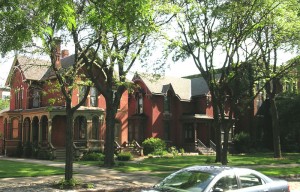First Step in Revitalizing Legacy Cities: Stop Digging the Hole Deeper (Part I)

By The Economic Development Curmudgeon
It’s no secret in economic development that some American cities are in deep, deep trouble. They are deep into a hole that at times seems bottomless.
Detroit made the headlines in recent months, but we all know that many Great Lakes big cities and several older manufacturing centers have very serious issues. The Curmudgeon spent a good chunk of his career in one legacy city, Erie County-Buffalo New York. He values that city and the friends he has there–but times are still unfriendly (despite some recent good news). These cities are politely and political correctly labeled as “legacy cities”. How to turn these cities around is one of the two or three most pressing issues in the profession.
Recently, the Lincoln Institute of Land Policy issued its report, Regenerating America’s Legacy Cities, which is based on years of research and analysis by its authors, Alan Mallach and Lavea Brachman. The thinking behind this report is truly the highest quality. The Curmudgeon believes it is the best summary of contemporary professional “conventional wisdom” outlining the path to legacy city revitalization. Let’s dig into the Lincoln Institute Report. But the Curmudgeon gives fair warning to the reader that with all the respect in the world to the Report and its authors, the we will challenge a major “plank” in contemporary conventional wisdom. For the Curmudgeon, the first step in legacy city revitalization is for these cities to “STOP DIGGING”: don’t make the hole they are in any deeper! How Legacy Cities can stop digging is decidedly unconventional—a departure from the conventional wisdom.
The Curmudgeon has several concerns with legacy city conventional wisdom, and he thought it only fair to alert the reader from the get-go. First, the conventional wisdom is predominately policy-centric. Plug in the correct policy and revitalization is on the way. Secondly, conventional wisdom embraces a form of regionalism which is destructive to the central city. Thirdly, There is an almost complete lack of concern on how to bring about change in the central city. It’s sort of like announce the correct policy and everybody lines up, cheers, and then follows orders in its implementation. It just doesn’t work that way, however. Accordingly, we are very concerned with understanding “the soft infrastructure of change” that must be a part of any legacy city revitalization and building that into the conventional wisdom. The most encouraging aspect of the Lincoln Institute Report is that finally, it recognizes the “soft infrastructure of change” by concerning itself with the need to “mobilize the assets of the legacy city”. What is this asset mobilization and why is it a dramatic addition to the conventional wisdom on legacy city revitalization?
Regenerating America’s Legacy Cities
The Lincoln Institute report identifies its eighteen “legacy cities” as central cities with a minimum population of 50,000 (2010) and which have suffered more than a twenty per cent loss in peak population. These cities are Akron, Baltimore, Birmingham, Buffalo, Camden, Canton, Cincinnati, Cleveland, Dayton, Detroit, Flint, Milwaukee, Newark, Philadelphia, Pittsburgh, St. Louis, Syracuse and Youngstown. Each legacy city was ranked on fifteen indicators:
- 2010 unemployment
- 2011 BA or higher degrees
- 2009 crime rate
- 2010 foreign born
- population loss from peak
- 2000-2010 population change
- 2011 % in poverty
- 2011 household dependency rate
- 2010 median housing sale price
- 2006-2010 change median housing price
- 2010 mortgage ratio
- 2010 housing vacancy rate
- 2011 grad student % of population
- 2008 total research funding
- 2002-2009 job change
Based on these variables, they constructed an index and ranking order from which the top three cities were: Philadelphia, Pittsburgh and Baltimore; and the bottom three cities were: Flint, Detroit, and Youngstown (see Table 3, p. 20 of the actual report). The indicators and the rankings guided the analysis of the Lincoln Institute report and informed its conclusions. But the report certainly cannot be accused of obsessing on the rankings or the indicators themselves. In short, the crux of the report is based more on its prescriptions and theoretical framework of the authors than drawn from the index and its rankings.
A glimpse at Table 3 (p. 20) of the report suggests that most individual legacy cities rankings ranged considerably across the fifteen indicators, but admittedly the three bottom cities were consistently low. Interestingly, however, the top three cities garnered a combined total of only four top rankings (1) out of forty-five possible. This is a bit of a puzzlement to the Curmudgeon and he is a bit skeptical concerning the eclectic variety of indicators employed and their internal consistency. However, since the rankings and indicators do not seem to be central to the prescriptions or even analysis underlying the report, we shall not dwell upon them in this review.
Why did legacy cities decline in the first place?
 Obviously, it is hard not to recognize that loss of population is the key driver of decline. But according the Lincoln Report what caused population loss. To coin a phrase, the usual suspects are all there in all their insidious glory, but the chief culprit is the ever despicable suburbanization “that left impoverished urban populations behind; and a reduced housing market demand that led to diminished property values and abandonment” (p. 2). Underlying the blame placed upon suburbs is a perspective” which assumes (1) that people should all live in a central city, and (2) they would still live in the central city if not driven out by private profit and corrupt federal/state public policy. Still, the core cause, however, of the legacy city decline is suburban-related population loss which triggers an almost fatal “capacity” crisis. The solution, logically, will involve restoring access to the lost population and its resources.
Obviously, it is hard not to recognize that loss of population is the key driver of decline. But according the Lincoln Report what caused population loss. To coin a phrase, the usual suspects are all there in all their insidious glory, but the chief culprit is the ever despicable suburbanization “that left impoverished urban populations behind; and a reduced housing market demand that led to diminished property values and abandonment” (p. 2). Underlying the blame placed upon suburbs is a perspective” which assumes (1) that people should all live in a central city, and (2) they would still live in the central city if not driven out by private profit and corrupt federal/state public policy. Still, the core cause, however, of the legacy city decline is suburban-related population loss which triggers an almost fatal “capacity” crisis. The solution, logically, will involve restoring access to the lost population and its resources.
More precisely, the conventional wisdom attributes population loss to the unnatural and immoral departure of people (rich, white, middle-class and boring) to the suburbs-abetted by federal government highways, mortgage interest deduction and investment depreciation on income tax. On top of this traditional brew of decline we add such seasonings as government fragmentation and sprawl to provide some flavor and robustness. In the good old days, racial change resulting from the Great Migration prompted much discussion along the lines that white rich (i.e. middle class) racists had moved out of the central city to the lily white rich suburbs to avoid migrants from the Great Migration. To some extent this old-style dialogue remains, muted to be sure, in the Lincoln Institute report:
Suburbanization exploded in the late 1940’s and 1950’s, driven by the demand for new homes and made possible by the automobile and by access to affordable mortgages. At the same time, millions of families were moving from the Northeast and Midwest to the Sun Belt. Race and income are inextricably interwoven in the postwar history of American cities as large-scale black in-migration into areas with declining economic opportunities led to conflicts, particularly during the 1960’s when many American cities exploded in racial violence. (p. 5)
This semi-implied cause of decline-population loss, however, has gone somewhat out of favor due to the awkward reality that racial minorities, and poverty as well, have since the 1990’s followed the racist and duped whites to the suburbs. The emigration of the black middle class to the suburbs in particular, when combined with the especially awkward trend of rich young creative professionals gentrifying many of our central city downtowns and inner ring neighborhoods, have toned down the associated noise which used to accompany the previous population dispersal rationale. If so we must reach deeper into our bag of explanations and dig out a substitute explanation for population loss.
The number one alternative to racism as a reason for suburban-induced central city population loss is the central city’s loss of manufacturing (deindustrialization) which was followed by job loss in the retail and service industries. Manufacturing plant closings started this sad parade of job loss in the sixties. These manufacturing jobs were the “engine of growth” for the legacy city. Lacking an economic engine, the passengers apparently got out of the jalopy and wandered to the suburbs where the jobs mysteriously reappeared–lured by highways, federal mortgages, mortgage interest deduction and business investment depreciation, real estate developers, new schools and God knows whatever else was thrown into the pot.
So conventional wisdom now asserts that, like an old Buick, these cities blew out their original engines and now need to have a new one installed. What does that new engine look like?
Let’s Drop a New Economic Engine into the Legacy Jalopy
 First let’s start with understanding what the Lincoln Institute wants to do. Warning that “Legacy cities face a difficult task in rebuilding their economies. They must grown new, export-driven economic activities to sustain a stable or growing population and restore their fiscal vitality. To the extent possible they must also reestablish their central roles in their regions and build new and meaningful identities around these new [regional] initiatives”. (p. 29)
First let’s start with understanding what the Lincoln Institute wants to do. Warning that “Legacy cities face a difficult task in rebuilding their economies. They must grown new, export-driven economic activities to sustain a stable or growing population and restore their fiscal vitality. To the extent possible they must also reestablish their central roles in their regions and build new and meaningful identities around these new [regional] initiatives”. (p. 29)
To the Curmudgeon this prescription is fairly clear: the new economic engine at its core is two dimensional (1) export-driven (a base industry) and (2) drawn from the initiatives which reestablish the central city as the dominant metropolitan leader. This latter dimension is critical to their perception of the endpoint of legacy city revitalization; they expect to return the central city to the dominant position in the metropolitan region. The Curmudgeon disagrees strongly with this position and his reaction to it will constitute a substantial place in the Part II to this article that will be issued two weeks from this issue (about February 4th). We don’t think that metropolitan economic and political leadership is either feasible or desirable. To attempt to restore the legacy to its “golden years”will invite continued legacy city frustration and stagnation.
If we postpone to Part II our discussion of the role of regionalism in legacy city revitalization, we should move onto a consideration of whether of not an export-driven economic engine has the horsepower to rejuvenate a legacy city.
To be fair the Lincoln Institute report never suggests that export-driven growth alone will be sufficient to drive a legacy city recovery. “Eds and Meds”, it seems to us, is their most favored single driver of economic development, and the best initiative to establish an export driven sector in the legacy city. But, frankly, the export dimension does not seem to be well developed in the report. Frankly, our sense this initiative is prioritized flows from conventional wisdom’s belief in knowledge-based economic growth which is epitomized in both “eds” and “meds”. There is a firm rejection of “import substitution” as a useful focus in revitalization. But, we confess that the Report really devotes only a few paragraphs to this export engine of growth, preferring instead to launch into a more extended treatment of “Building of Assets for a Competitive Advantage”.
“Legacy cities can build new economic functions by identifying assets that can yield competitive advantages” (and they devote a full page table to specific “assets that represent opportunities for economic growth” (p. 31)). Implying no criticism at all, it seems to the Curmudgeon that some strategies listed in this table are more implementable than others. Most are pretty general and border on platitudes. Still others are more concrete and in the Curmudgeon’s opinion do constitute viable strategies for playing a role in restoring the legacy city’s economy–but they certainly break no new ground and are probably already incorporated in most legacy city economic development plans.
Forgive us for saying that Table 5’s list and summary of potential assets is little more than a shopping list. We do call attention to this because it reminds the reader of why a legacy city is so hard to revitalize. It’s easy to talk about it and throw out ideas, especially those ideas which are part of the latest and greatest buzzing about the blogosphere, but try taking any of these listings and attempt to make them real. None yield, for instance, discernible short-term benefits which could sustain consensus and political support necessary for any revitalization strategy. And how does “Use downtown workers to catalyze downtown housing and restaurants”, “promote immigration” or “attract artists to neighborhoods” really get at the core of replacing the legacy city’s broken engine of economic growth. This listing sounds more like a philosopher telling a car mechanic how to (ontologically) install a new engine in a car. So much for “building on assets for competitive advantage”!
BUT the second dimension of the Lincoln Report’s “New Economic Engine” is to “Reestablishing the Central Role of the City” (which goes on and on from p.32 to p. 43) is the core of the legacy city’s new economic engine . We remind the reader that we talked about this earlier and indicated this subject will be dealt with in Part II. At this point there is no escaping, in our opinion, that the real horsepower behind the Lincoln Institute model (and conventional wisdom) of legacy city’s economic revitalization revolves around “reestablishing the central role of the legacy city” in the metropolitan region. The Curmudgeon, we tirelessly stress, is more wedded to trying to integrate the legacy city into a multi-nodal metropolitan region, but he will make that case in Part II soon to follow.
Anyway, reverting back to our much maligned Table 5 shopping list of assets potentially useful in a legacy city revitalization, the Curmudgeon and the Lincoln Institute agree on several approaches to rejuvenating the central city economic engine.
We are not especially enamored with “traditional walkable downtowns” (a bit too rigid for the Curmudgeon’s taste), the CBD is the perceptual heart of the central city. The CBD has largely maintained its “governmental function” (see–the Curmudgeon can invent functions also), that’s a nine to five phenomenon. We need the CBD to have a 24/7 life to it and certainly arts and culture, CBD housing, as well as entertainment complement can build a more vibrant downtown and lend substance to a sustainable coalition for longer-term revitalization efforts.. Frankly, we doesn’t see much potential for success in restoring the legacy city economy without finding some way to at least perceptually strengthen the downtown. For better or worse, many judge urban areas by the vitality of the downtown-CBD core and to ignore that is to place a serious impediment on legacy city regeneration. There is nothing new in this observation–but so what!
Strong neighborhoods are a sort of platitude–no one advocates for weaker neighborhoods. But neighborhoods are based on their residents–their resilience and their distinctive spirit, even more than their physical assets. To the Curmudgeon the inescapable reality of neighborhood revitalization is bringing the working and middle classes back into the legacy city neighborhoods–and that ain’t easy. When we judge the condition of legacy city neighborhoods on the basis of how much they draw their economic sustenance from government programs we instinctively should sense we have a set of problems present in a legacy city neighborhood which are beyond the capacity of any city to solve. You can try to relocate artists into these neighborhoods, but somehow they isn’t going to do the job of revitalizing them. As implausible as it seems, we believe that migration out of central city neighborhoods is what caused the present crisis and that continued migration out of these neighborhoods might help solve it–when combined with gentrification.
Legacy city neighborhood renaissance, in our perspective, is not likely to be achieved by “gilding the ghetto”, but rather by de-concentrating urban poverty. This can only be accomplished if either or both the present residents continue to migrate to other neighborhoods or new more affluent residents move in. To the extent that such migration crosses central city boundaries into suburbs means that another set of hands becomes involved in dealing with these issues. The affected suburbs might wake up and realize they must partner with the central city in a solution. How all this plays out is, of course, anyone’s guess, but throwing more government programs and skills training at current residents does not seem to be working out. Crime rates are rising and these neighborhoods are deteriorating at a rate than many cannot be brought back in any reasonable period of time. Manipulating population migration in and out of our neighborhoods is worth a try.
Sill, the traditional “gild the ghetto” answers (education and training for jobs) cannot be ignored. Crime reduction and rebuilding K-12 are probably the two best economic development strategies for a legacy city. The latter will take generations to take effect and the morass that K-12 education reform has degenerated into suggest that legacy city revitalize is strongly tied to this nation (or the states) coming to grips with educational reform. Legacy cities and central cities in general are being held hostage by our broken media and politics. If education is to break up urban poverty concentration, as it did in our past history, we’ve got to grab a hold of solutions and resources way beyond the capacity of any single legacy city. In the meantime, as a holding action, initiatives ought to be launched to repair and replace neighborhood infrastructure. demolish vacant housing on a radical scale, and finally, the provision of effective fire and police services.
Our final comment on the Lincoln Institute economic engine is that no where do we really see a major role for private industry. The private sector is notable in its absence (restricted to “growth of local manufacturers”, p. 31). To be fair, the report does involve the corporate governance in its regionalist focus, but not really in its economic engine focus. If anything, non-profits are regarded as the drivers (Eds and Meds, Arts, Culture, Foundations, community-based and economic development entities). Even government is not stressed. Fiscal reform and governmental capacity-building, not to mention effective service delivery while included (see p. 35), do not come off as center piece elements of restoring the central city economic engine. The Curmudgeon would revisit this deficiency and find a much more robust role for these two dynamic forces (government and the private sector) in any revitalization effort. This concern is a major deficiency of conventional wisdom. 
As summarized in Chapter 5 of the Report, the below are the key components for legacy city revitalization suggested by the Lincoln Institute Report:
- Rebuild the central core
- Sustain viable neighborhoods through targeted investments
- Repurpose vacant land for new activities
- Use assets to build competitive advantages
- Re-establish the central economic role of the (central) city
- Use economic growth to increase community and resident well-being
- Build stronger local governance capacity and partnerships
- Increase the ties between legacy cities and their regions
- Rethink state and federal policy toward legacy cities
The Proposed Lincoln Institute Path to Regeneration
The Curmudgeon is quite sympathetic to the Lincoln Institute’s approach to the “process” behind legacy city revitalization. The Lincoln Institute approach, once we put restoring the central city to a hegemony over the metropolitan area aside to Part II, the Lincoln Report in its Chapter 4 breaks new and very helpful ground.
Their approach is to “leverage community assets” to overcome barriers to successful change by “uncoupling (legacy city leadership, citizens and business) from prior patterns of thinking and acting in order to adopt new ones” (p. 44). To accomplish this feat, the Lincoln folk advocate the central city governance embrace a”strategic incrementalism”making approach.
“Two central themes that underlie … (legacy city regeneration) are: the assets that each city brings to bear and the way in which those assets are used to foster change; and the relationship between the city and the surrounding region”. (p. 11)
For hopefully the last time in this issue, we will pick up in two weeks with Part II and the relationship between the central city and the surrounding region”. In this issue we concentrate on “the assets that each city brings to bear and the way in which those assets are used to foster change”. This is the part of the Lincoln Report which we believe to be its most helpful and path-breaking finding. In this section the Lincoln Report authors roll up their sleeves and tackle HOW and by what PROCESS a strategy of legacy city revitalization and be forged and achieved. The key to their approach is to use the assets found in each central city and harness them behind a consensual revitalization strategy. The process by which those assets are harnassed is called “strategic incrementalism”.
Each legacy city possesses its own distinctive set of institutional (organizational) assets. These assets, or at least a powerful coalition of them, can and must be effectively brought together behind a sustained commitment to a shared revitalization strategy. Institutional “Assets Matter”; they are the building blocks necessary to forge a “renewed competitive advantage, which will enable them to build new economic engines and draw populations, is likely to come from leveraging the value of these assets” (p. 11) . Institutional Assets come in many sizes, shapes and forms; some examples include: downtown, stable neighborhoods, historic buildings, arts, cultural and entertainment institutions, bodies of water, multi-modal transportation networks, higher education, hospitals and medical centers, key manufacturing firms, and regional growth (see Table 1, p. 12, for a complete list). Conventional wisdom has always said one must build upon one’s strengths and the Lincoln Institute approach therefore embraces this whole-heartedly. But, the Lincoln folk take the conventional wisdom a bit further.
First, the scale (size) of the asset is a critical, but not sufficient variable in the usefulness of the asset. That means that although the legacy city may possesses an asset, it does not mean the asset is “large enough” to be useful in a revitalization effort. In addition, the ability of the community and its leadership to “access” legacy assets (recruit them to participate in a more than rhetorical fashion) and the “qualitative” (a value-added dynamism–competent and charismatic asset leadership) also are critical to an asset’s value in the legacy city regeneration effort. Lincoln Institute does raise the issue that simply identifying local institutions as assets does not mean they are an “effective” asset in a revitalization initiative.
Assets do not leverage themselves. Most assets merely represent the potential for urban regeneration …. potential requires leadership and investment, and in the case of major institutions located in the city, the commitment must be reciprocal. The institution must be dedicated to use its resources to improve the community, while (local government/leadership) must be ready to partner with the institution … (p. 12)
Sadly, the report is written in think tank-academic generalities, but this qualification of the quality of a legacy asset is very important. Assets to be used by a legacy city ought to be of a scale sufficient to the task–for example, a hospital is not the Mayo Clinic. Colleges and universities are not identical and equally instrumental to a revitalization effort. Large manufacturing (and service) firms are not all dynamic job creators; some just employ a lot of people, but don’t really grow. Scale assets cannot be created out of red clay and there is no law or requirement that any legacy city has such an asset sufficient for its task.
The report is optimistic and merely asserts the asset are there in each and every legacy city–but the Curmudgeon is more than skeptical. One of the issues underlying legacy cities is that their scale assets may have sickened and passed on to legacy-asset heaven or may have lost its former “scale”. Logically, it may be that the legacy city may have a mixture of assets, but those assets, even if combined and unified in a revitalization strategy, do not amass sufficient scale to propel regeneration.
The implications of that sad reality, if correctly reflecting any particular legacy city, are huge! When one considers the scale and quality of each legacy city’s institutional and physical assets, some cities may be more favored than others. In any case, the condition of a legacy city’s assets and their suitability/utility to an effective revitalization coalition is a huge step forward in our understanding of a legacy city’s prospects for success. Finally, we have stepped beyond the mere adoption of correct politics as the key to regeneration; we now should embrace the capacity of a legacy city’s physical assets and institutions to effectively participate in a sustained strategic incremental process of reform and change.
Secondly, assets even if of sufficient scale, may not be accessible or able to participate in a city’s regeneration effort. For example a scale asset may be an element of the state university system or a private firm or institution not headquartered in the city or region. Even if accessible (and willing to participate in city revitalization) a scale asset may have its own set of problems which divert its focus and resources, or possess a “convoluted-decentralized” internal decision-making process which makes it in critical ways dependent on an external headquarters or decision-maker. School systems, for example, are central to a legacy city strategy and they are responsive to an entirely non-local set of forces which can foster or inhibit their participation in a local strategy–and are we really sure who “governs” our school districts? Or the asset may simply lack discretionary resources to attack fundamental core problems outside its core concerns and business model. Institutional assets even if sufficient scale and willingness to participate are evident, may not be able to involve itself effectively over time in a revitalization strategy.
The participation of a scale asset over a relatively long period of time is also an issue. As suggest above assets have their own problems and ultimately are responsible to their governance and clients. Partnerships with assets to accomplish non-institutional objectives can be very complicated and very fragile–maintaining a more than rhetorical partnership over time is a real challenge–especially if the asset includes suburban interests, facilities and clients which are upset with a regionalist hegemonic strategy by the central city. Regionalism in real life can divide elites and masses and makes partnerships more difficult to forge and sustain. Regionalism is only one factor that can inhibit an asset from participating in a revitalization effort.
The Curmudgeon appreciates the centrality of legacy city assets in a successful regeneration strategy but having introduced the issue of asset scale and quality, the Report did not go far enough in our opinion, to penetrate the complexity of asset participation in a sustain legacy city strategic incremental policy process. Perhaps more sadly, the report suffers from its overly optimistic catalog of successful assets employed thus far by legacy cities. Every legacy city has something going for it. How nice! To be sure it is not the role of the Lincoln Institute, nor of the Curmudgeon, to critique (disparage) the “great” assets found by the Report to exist in the eighteen legacy cities. But, the reader might keep in mind that if these assets and programs so successful, why was this Report written?
In any case, legacy cities, as the Lincoln Institute recognizes, are not simply an economic base which simply needs a new cluster grafted onto the old dead broken ones. Legacy cities are an aggregation of institutions and assets many of which needs be harnessed if revitalization is to occur. The recognition of complexity behind economic growth, that it is much more than the adoption of the correct set of revitalization policies, is so badly needed in view of many oh-so-popular-legacy city solutions (such as innovation, knowledge-based economies-creative classes–and everybody’s favorite—the new cluster to be constructed from scratch by government programs) that are tossed around.
Why Part II in Two Weeks
We could tell the reader the truth and the truth is that this issue presents a hopefully fair critique of the Lincoln Institute Report which we believe to be a metaphor for the conventional wisdom regarding legacy city revitalization. That is enuf for one sitting. Still, we have point our several concerns which we have not developed–and should be. The reliance upon regionalism of a certain hegemonic nature is in our mind a killer for any serious hopes of legacy city revitalization. In our mind the conventional wisdom’s concept of legacy regionalism needs to be critiqued in its own right. Look for that in Part II.
Secondly, we want to expand on “solutions”. Legacy city salvation in today’s environment is starts with stopping digging the hole and begin to fill it in. Conventional wisdom and the Lincoln Institute Report see that accomplished through its form of regionalism; we see it otherwise–through politics and partnership and developing a consensual belief the city can be saved and it is worth trying to save it. That solution is less economic than political in nature–and we want to develop that further.
Finally, we want to develop at least a bit more the notion of the soft infrastructure of legacy city change. If policy alone is not sufficient to revitalize legacy cities, how does one go about assembling a coalition for change (back to asset mobilization again) that can be effective? This is where our second and third points dovetail; to the Curmudgeon, the key to herd this bunch of institutional-economic asset cats is charismatic political leadership. So we want to develop that them as well.
Hopefully, the reader’s interest has been whetted and not sapped by Part I. Part II is on the way and watch for it the first week in February.






Comments
No comments yet. You should be kind and add one!
The comments are closed.